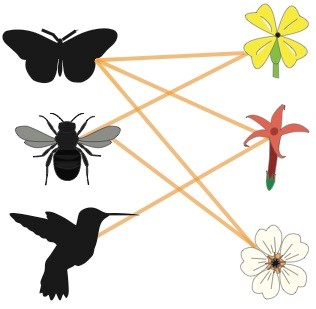Testing how antagonistic interactions impact the robustness of plant-pollinator networks
DOI:
https://doi.org/10.26786/1920-7603(2019)540Abstract
Given ongoing pollinator declines, it is important to understand the dynamics of linked extinctions of plants driven by pollinator extinctions. Topological robustness models focused on this question suggest relatively high robustness of plant species to pollinator species extinctions. Still, existing robustness models typically assume that all interactions in plant-pollinator networks are positive, which is clearly not always the case. For example, many pollinators remove floral resources without transferring pollen, or even damage floral structures in the case of nectar robbing. Here we introduce antagonistic interactions into plant-pollinator networks and assess the resilience of plant communities to pollinator species losses. Incorporating antagonistic interactions leads to lower network robustness, i.e. an increased rate of plant species loss (as compared to networks with only mutualistic interactions) in empirical plant-pollinator networks. In conjunction with extinction order, the addition of increasingly antagonistic interactions was idiosyncratic in that it did not always magnify the effects of extinction order across the three networks. These results underscore the importance of considering the full spectrum of interaction outcomes when assessing robustness to coextinctions in plant-pollinator networks, as well as other ecological systems.
Downloads
Published
How to Cite
Issue
Section
License
Copyright (c) 2019 Heather Briggs, Carolyn A. Ayers, Paul R. Armsworth, Berry J. Brosi

This work is licensed under a Creative Commons Attribution 4.0 International License.
JPE is an open access journal which means that all content is freely available without charge to the user or his/her institution.
Authors who publish with this journal agree to the following terms:
1) Authors retain copyright and grant the journal right of first publication with the work simultaneously licensed under a Creative Commons Attribution License that allows others to share the work with an acknowledgement of the work's authorship and initial publication in this journal.
2) Authors are able to enter into separate, additional contractual arrangements for the non-exclusive distribution of the journal's published version of the work (e.g., post it to an institutional repository or publish it in a book), with an acknowledgement of its initial publication in this journal.
3) Authors are permitted and encouraged to post their work online (e.g., in institutional repositories or on their website) prior to and during the submission process, as it can lead to productive exchanges, as well as earlier and greater citation of published work (See The Effect of Open Access).
To assure a broader targeted audience, content will be included into databases (such as EBSCO) and directories (such as DOAJ).











